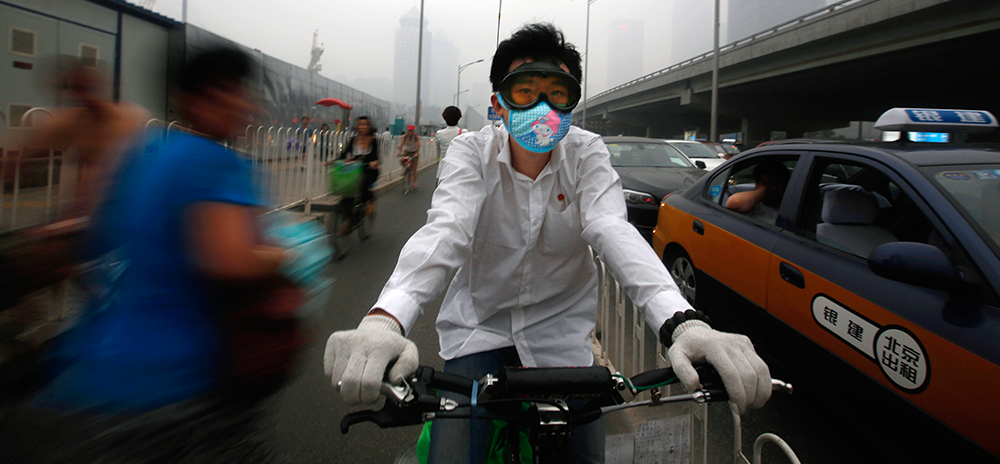
This Beijing bicyclist was Greenstone’s exhibit number one for the pollution costs of China’s economic progress. (Photography by How Hwee Young)
Economist Michael Greenstone studies the human cost of China’s pollution in the Huai River Valley.
One of the first bits of evidence that UChicago economist Michael Greenstone, LAB’87, showed his audience during a January symposium on pollution in China was a photograph. In it, a Chinese man rode a bicycle. He wore goggles, his electric blue facemask standing out against the bleak gray sky.
“While economic progress has led to incredible improvements in well-being in China, it hasn’t come for free,” Greenstone explained. The cyclist in the photo “feels compelled to wear a face mask to block out the pollution. And for those of you who’ve been to China, in many of the big cities it’s not uncommon that you can go days without seeing the sun.” Greenstone, director of the Energy Policy Institute at Chicago (EPIC) and director of UChicago’s Energy and Environment Lab (part of the new Urban Labs initiative) was speaking at a symposium called China’s Pollution: The Costs, Challenges, and Steps Forward, cohosted by EPIC, the Paulson Institute, and the University’s Center for International Studies.
To illustrate the costs of pollution in China, Greenstone presented research on the effects of pollution on life expectancy. The Huai River plays a central role in the research; it is the dividing line between north and south China—in the winter, temperatures north of the river are normally below freezing (including in Beijing), while those in places south of the Huai River are generally above freezing.
A government initiative colloquially called the Huai River policy provides free coal during winter months to residents living on the north side of the river. Greenstone said that while the policy initially seemed beneficial, it caused a sharp difference in air pollution between north China and south China. Zhu Rongji, China’s former premier who had been a resident of Shanghai, told Beijing officials in 1999, “If I work in your Beijing, I would shorten my life at least five years.”
Greenstone set out to test the premier’s claims. A past member of the EPA Science Advisory Board’s Environmental Economics Advisory Committee, a faculty director of the E2e Project (an initiative devoted to finding cost-effective ways to reduce fossil fuel consumption), and the Milton Friedman Professor in Economics at UChicago, he’s an expert in energy and environmental economics. His team looked at the levels of airborne particulate matter pollution on both sides of the Huai River. (Particulate matter is composed of air carcinogens containing solid particles and liquid droplets of hundreds of chemicals.) The study is based on the idea that the particulates are the only determinant of life expectancy that discretely differ on the north and south sides of the river. Indeed, they found support for this assumption in other observable determinants of health, like smoking and diet.
The team found that north of the Huai River, where there were heating units, suspended particulates concentrations were about 550 micrograms per cubic meter, compared to roughly 350 micrograms per cubic meter south of the river. Greenstone pointed outside, to the Chicago winter sky. “If you want to put that in context, because it’s a really enormous number, outside today I suspect it’s like 50.”
By focusing on the area surrounding the Huai River, Greenstone’s team was able to compare life expectancies of the people living to the north and to the south: one set of data including the pollution from the heating units, and one without. To even Greenstone’s surprise, the data showed that people in the north are living about five and a half years less than people in the south.
To ascertain that this difference in life expectancy was coming from the Huai River policy’s particulates and not other factors, Greenstone tested the levels of other air pollutants on the north and south sides of the river. Also to confirm that the causes of death were related to air pollution in general, he isolated the data of people who died from cardiorespiratory causes. He found that the elevated mortality rate was almost entirely due to a 37 to 50 percent increase in the cardiorespiratory mortality rate, suggesting strongly that there is a relationship between life expectancies and air pollution.
Greenstone emphasized that reducing particulate concentrations is important all over the world. “Obviously if you’re in China, the Huai River policy is incredibly important. If you’re somewhere else in the world, what you really might be interested in is, well, if you give me a 100 unit change or a 50 unit change in particulates, what is that going to mean for my life expectancy?” For those who live somewhere with a hundred extra micrograms per cubic meter of particulates, he says, “life expectancy will be reduced by somewhere between two and three years.”
Applying that number to India, he concludes that the 660 million people in regions where pollution concentrations exceed India’s standards would live more than three years longer on average by bringing the country into compliance with its own environmental codes. Greenstone’s work is important not only to the more than 500 million in northern China (who collectively are losing 2.5 billion life years) but to those who breathe polluted air everywhere in the world.
